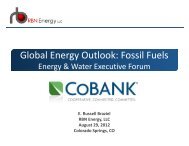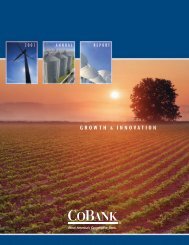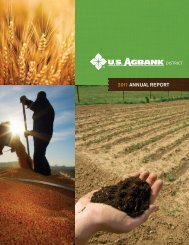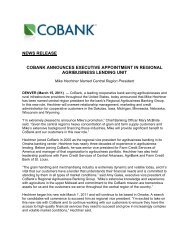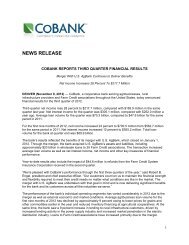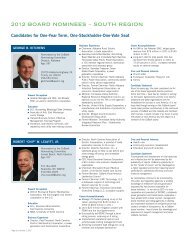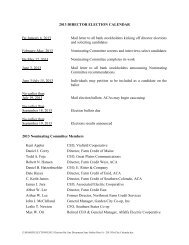India: The Other Asian Giant - CoBank
India: The Other Asian Giant - CoBank
India: The Other Asian Giant - CoBank
You also want an ePaper? Increase the reach of your titles
YUMPU automatically turns print PDFs into web optimized ePapers that Google loves.
OUTLOOK www.cobank.com<br />
In the next decade, one out of four people joining the<br />
global workforce will be <strong>India</strong>n. That’s a phenomenally<br />
young population joining the workforce that can drive<br />
the country’s growth in a significant way.<br />
Devesh Kapur: <strong>India</strong> today is the world’s 10th-largest economy and the<br />
fourth largest in terms of purchasing power. By the end of the decade, <strong>India</strong><br />
is expected to be the fifth-largest economy and the third largest in terms of<br />
purchasing power.<br />
About this article<br />
Nicholas Burns is a professor at<br />
Harvard University and former U.S.<br />
undersecretary of state for political<br />
affairs. At Harvard, he serves as Professor of the<br />
Practice of Diplomacy and International Politics<br />
at the Kennedy School.<br />
Mr. Burns is a member of the Council on Foreign<br />
Relations and served in the U.S. Foreign Service<br />
for 27 years until his retirement in 2008. He<br />
was Under Secretary of State for Political Affairs<br />
from 2005 to 2008 and also served as U.S.<br />
Ambassador to NATO (2001–2005) and to<br />
Greece (1997–2001) and as State Department<br />
Spokesman (1995–1997).<br />
He earned a bachelor’s in history from Boston<br />
College, a master’s in international relations<br />
from the Johns Hopkins School of Advanced<br />
International Studies and earned the Certificat<br />
Pratique de Langue Francaise at the University<br />
of Paris-Sorbonne.<br />
Much of that growth has come from information technology, which grew<br />
from a $10 billion industry in 1990 to $100 billion today. <strong>The</strong> country also<br />
has a rising middle class of more than 200 million people with discretionary<br />
spending who are driving consumer demand for cell phones and cars. <strong>India</strong>’s<br />
favorable demographics also make the country very promising: In the next<br />
decade, one out of four people joining the global workforce will be <strong>India</strong>n.<br />
That’s a phenomenally young population joining the workforce that can drive<br />
the country’s growth in a significant way.<br />
OUTLOOK: How has <strong>India</strong> changed over the past 20 to 30 years?<br />
NB: <strong>India</strong> has seen remarkable change. From its founding in 1947 to the<br />
early 1990s, <strong>India</strong> operated as a semi-closed economy with a heavy dose<br />
of state socialism and restrictions on investment and trade. <strong>The</strong>n, in 1990<br />
and 1991, a series of economic reforms opened up <strong>India</strong> to the international<br />
economy. Those reforms enabled competition, opened up investment and<br />
trade and led to the great expansion of <strong>India</strong>’s economy.<br />
DK: In the past 20 years, the growth rates basically doubled and the<br />
population growth and per capita growth rates tripled. Indicators like literacy,<br />
life expectancy, infant mortality all have seen considerable improvements.<br />
OUTLOOK: What about its population growth?<br />
DK: <strong>India</strong> is likely to surpass China in population in the next few decades. To<br />
give you one way to think about it: In the 20 years between 1991 and 2011,<br />
<strong>India</strong> added 364 million people to its population. That’s more than the total<br />
population of the United States. <strong>The</strong> country has added more people in 20<br />
years than it did in two millennia. That is putting considerable pressures on<br />
natural resources and at the same time driving growth.<br />
2



